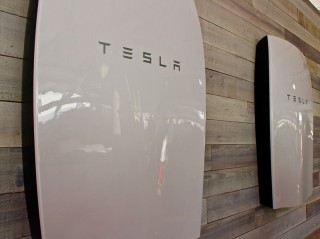In our constant drive to reduce global warming and climate change we see wind, sea and solar power as possible solutions, but they have not been as successful as many would have us believe in reducing our carbon footprint. Do new advances in battery technology provide “the missing piece”?
Are renewable’s helping?
Using nature as a means to provide us with energy has faced two stumbling blocks.
Firstly nature isn’t that reliable. It isn’t sunny all the time and it isn’t windy all the time.
When it comes to wind turbines this has been highly controversial. Many wind farms that are supposed to be

generating electricity actually sit idle for long periods of time. When they are not in motion they are actually a draw on power due to the braking system which is needed to keep the blades moving very slowly to avoid damaging their bearings.
This has all caused anger because taxpayer subsidies aren’t delivering results and local residents often feel their lives have been disrupted with governments funding dubious projects.
Secondly we need a great deal of energy when natural resources aren’t around. It’s exactly when the sun has gone down that we need more light and heat, but solar panels are not delivering.
With renewable’s being unpredictable sources, there is also a darker side to them. The backup sources, traditional power stations, need to be ready at all times …
When we’re green we’re not always clean
There have been numerous positive headlines about what percentage of our power is coming from renewable sources. In 2017 the UK announced it had gone an entire day with electricity only from renewable’s.
But even this is not as it seems. Coal, nuclear and gas turbine power stations take hours, or even days to ‘ramp up’ or ‘ramp down’. These terms refer to how fast they can move from producing a certain amount of power to a higher or lower outputs.

The process is slow while changes in wind and sun resources can be fast. To be a safe backstop traditional power stations need to be waiting, ready to step in when the wind drops or the clouds come over.
In the industry this status is known as ‘cycling’. They are still burning coal and gas at or close to their normal rates, they are still polluting the environment, they are still generating electricity, it’s just that we aren’t using it!
So while politicians have been keen to highlight how much renewable energy we are sourcing, they have been much quieter about its real impact on pollution, because it isn’t actually replacing it. They will often talk about things that are ‘potential’ or ‘possible’ rather than actual.
Why can’t we store energy from renewable’s in batteries?
This has been a part solution for some time. However it has set backs. Batteries do not last forever, even if they are unused or kept at perfect states of charge. Their internal components gradually degrade over time and need to be replaced every so often.
Production and disposal of batteries, even recycling, has an environmental impact. Questions have been raised about whether or not their use, when this is taken into account, really helps us reduce our carbon footprint.
A detailed Swedish study in May 2017 concluded “ that the currently available data is usually not transparent enough to draw detailed conclusions” and this report only attempted to look into basic battery production.
The second black mark against batteries is that they are bulky and so need large storage areas, which in themselves must be kept dry and heated or cooled as needed. In other words the energy storage itself needs energy!
The third obstacle is that they are not that efficient – they waste large amounts of their own energy during the charging and discharging process, much of which ends up as heat.
All these factors have meant that storing natural energy in batteries hasn’t provided a guaranteed green solution yet.
The battery breakthrough?
In 2015 Tesla, well known for their electric cars, announced they had the answer. Elon Musk said what many had known in the backrooms for decades, “The problem with existing batteries is they suck!” Tesla, he claimed, had one that didn’t.

Tesla’s answer is their PowerWall, first released in late 2016. Slimline and swish along with a funky modern design it answered the first issue of where to put something as ugly as a battery. Well hang them proudly on your wall of course!
In October 2017 the PowerWall 2 became available. Harnessing further advances in the technology of lithium ion batteries, Tesla claimed that its PowerWall 2 would last at least 10 years (or more accurately 3,200 cycles – full discharges and recharges). That means less environmental impact from production and disposal especially when compared to other battery types such as lead acid which struggle to reach 300 deep cycles.
These new generation units also waste far less of their energy through heat or other processes that turn their chemical content into electric current. Like all batteries efficiency declines with age and use, but Tesla claims the PowerWall is still 70% efficient after 10 years which is impressive in the world of portable power.
Have we just saved the planet?
Elon Musk described Tesla’s PowerWall as “the missing piece” that will allow renewable energy to start making sense and actually begin a meaningful reduction in our carbon footprint when it comes to power generation.
As someone with a product to sell, he wouldn’t say otherwise, but we’re probably not quite there yet even though the PowerWall 2 represents a huge step in that direction. Solar Estimate have looked into Tesla’s latest offerings and found that with an all in price tag of $7,500 for the full product and solar panels, an American household will only be better off over the 10 year warranty period if they currently pay more than $0.139 per kwh … and there are plenty who don’t.
It is also for many an upfront cost they simply can’t afford when the payback period is so long.
There would need to be some political forces applied (such as higher taxes on coal and gas power production or consumption or subsidies on Powerwalls) to tilt this balance, but there is no particular sign that such a will exists.
Alternatively the price tag on Powerwalls needs to come down and that is probably the most likely outcome as it has been with so many new technologies.
The future of renewable energy storage
What Solar Estimate notes is that between releasing PowerWall 1 in late 2015 and PowerWall 2 in October 2016 Tesla managed to double some key performance factors such as the power storage abilities.
This, along with the global focus on improving electric vehicle abilities, means that optimistically we may be only a short step away from a PowerWall that makes financial sense to the majority.
There are plenty of reasons to back that optimism. The drive may come from other markets such as Europe where energy prices from traditional sources are already on the rise. In August 2017 IKEA announced it would start retailing its version of the Powerwall and they are not alone.
Big names like Nissan, LG and Mercedes are just a few multinationals keen to get a slice of the cake, driving competition to improve offerings and pushing down prices through mass production.
Is it all rosy?
There is a potential that such dramatic improvements as Tesla and their competitors have achieved may actually hinder the market. Consumers may think – Why make the major investment in a Powerwall 3 when a much better and cheaper Powerwall 4 might be just around the corner?
There may also be some political headwinds because if millions of people start moving off grid, there will be an inevitable amount of jobs to be lost in traditional power generation fields.
Also lurking are some uncomfortable questions lingering in the background about the entire ‘cradle to grave’ costs and environmental impacts that these units have. These have been mainly resolved for electric cars when we look at their entire lifetimes, although not all are completely won over.
It takes more energy to build an electric car than one which runs on gasoline, but over the entire lifespan the battery powered auto is the greener by up to 50% according to LikeTesla. They estimate the difference is 160,000 pounds of greenhouse gases that are created by a gasoline powered car from production to disposal compared to 82,000 pounds for electric. Their critics say they would say that because they ‘Like Tesla’ and that the full analysis is much more complex.
The same controversy probably awaits Powerwall style technology. Lithium-ion batteries, the chemistry within the Powerwall, are energy intensive to make and energy intensive to recycle.
Despite these obstacles, the media are firmly sided, and so our shift to move off grid may not only be imminent, but also inevitable.


Leave A Comment?